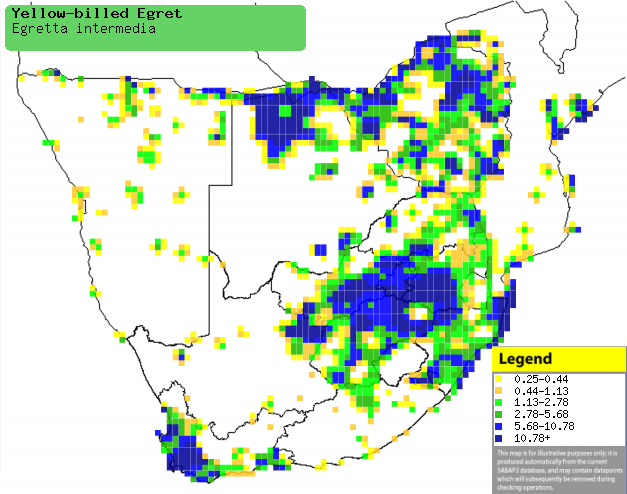|
Egretta intermedia
(Yellow-billed egret, Intermediate egret)
Geelbekwitreier [Afrikaans]; iNgekle (also applied to Little egret)
[Zulu]; Esingangombe (also applied to Yellow-billed egret) [Kwangali];
Leholosiane (generic term for egret) [South Sotho]; Middelste zilverreiger
[Dutch]; Héron à bec jaune [French]; Edelreiher, Mittelreiher [German];
Garça-branca-intermédia [Portuguese]
Life
> Eukaryotes >
Opisthokonta
> Metazoa (animals) >
Bilateria >
Deuterostomia > Chordata >
Craniata > Vertebrata (vertebrates) > Gnathostomata (jawed
vertebrates) > Teleostomi (teleost fish) > Osteichthyes (bony fish) > Class:
Sarcopterygii (lobe-finned
fish) > Stegocephalia (terrestrial
vertebrates) > Tetrapoda
(four-legged vertebrates) > Reptiliomorpha > Amniota >
Reptilia (reptiles) >
Romeriida > Diapsida > Archosauromorpha > Archosauria >
Dinosauria
(dinosaurs) > Saurischia > Theropoda (bipedal predatory dinosaurs) >
Coelurosauria > Maniraptora > Aves
(birds) > Order: Ciconiiformes
> Family: Ardeidae
Distribution and habitat
Occurs from India, Australia, Japan and South-East Asia to
sub-Saharan Africa, where it is uncommon to locally common in central and
southern Mozambique, Zimbabwe, northern and eastern Botswana, the Caprivi Strip
and other patches of Namiba and South Africa, largely excluding the Northern and
Eastern Cape. It generally favours seasonally flooded marshes and grassland; the shallow margins of lakes; saltpans; estuaries and rivers.
|
 |
|
Distribution of Yellow-billed egret in southern Africa,
based on statistical smoothing of the records from first SA Bird Atlas
Project (©
Animal Demography unit, University of
Cape Town; smoothing by Birgit Erni and Francesca Little). Colours range
from dark blue (most common) through to yellow (least common).
See here for the latest distribution
from the SABAP2. |
Predators and parasites
Movements and migrations
Generally resident, although it may make local
movements in response to changing water levels.
Food
It eats mainly small fish, frogs and aquatic insects, doing
most of its foraging in shallow water or grass, slowly walking around and
stabbing at prey. It may also hover over the water before diving headfirst,
sometimes following Hippopotamus (Hippopotamus amphibius)
and catching prey in its wake. The following food items have been recorded
in its diet:
- Vertebrates
- fish
- frogs
- Cacosternum boettgeri (Common caco)
- Xenopus laevis (Common platanna)
- Pyxicephalus adspersus (Giant bullfrog)
- Kassina maculata (Red-legged kassina)
- Hyperolius pusillus (Waterlily reed frog)
- chicks of Euplectes afer
(Yellow-crowned bishop)
- Invertebrates
- insects
- aquatic insects and their larvae
- grasshoppers (Orthoptera)
- Talorchestia capensis (Beach hoppers)
Breeding
- Monogamous, usually nesting in mixed-species colonies of water birds, with
roughly 2-70 breeding pairs of Yellow-billed egrets scattered across the
colony.
- The nest is built by the female with material delivered by the male,
consisting of a platform of reeds and sticks, lined with grass and typically
placed in a tree or reedbed.
- Egg-laying season is from July-March, peaking from September-February.
- It lays 2-3 eggs, which are incubated by both sexes for about 24-27
days.
- The chicks are brooded and fed by both parents, leaving the nest at
about 21 days old and fledging roughly 35 days later.
Threats
Not threatened, although sensitive to disturbance while
breeding.
References
-
Hockey PAR, Dean WRJ and Ryan PG 2005. Roberts
- Birds of southern Africa, VIIth ed. The Trustees of the John Voelcker
Bird Book Fund, Cape Town.
|
